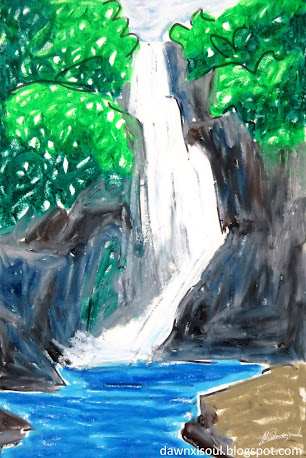May 6 (Lunar calendar: March 17), 2023 Saturday | Dawnxisoul393art
The days of strong wind in Hong Kong have finally passed. It was a beautiful day in the golden autumn of October and our family went to the sea god Hung Sage temple on Kau Sai Chau Island in Sai Kung, Hong Kong to sketch. Kau Sai Chau Island is the largest island in Sai Kung and the sixth-largest island in Hong Kong, with an area of 6.69 square kilometers. The islanders used to live by fishing, farming, and drying salt. Because of Hong Kong's economic changes and population migration, it is now sparsely populated. At the southern tip of Kau Sai Chau Island, there is an ancient fishing village - Kau Sai village, which still retains its ancient and simple appearance. The Haishen Hong sage temple in Kau Sai village, Sai Kung, Hong Kong is a temple worshipped by Sai Kung fishermen. The sea god Hung Sage temple is the only temple in the village. Its founding year is unknown, but it is certain that it was completed before 1889 and rebuilt in 1894. The sea god Hung Sage temple is a typical rural temple, which is a place where villagers of Kau Sai village who live by fishing worship the sea god Hung Sage.
The main hall of the temple of the Sea God Hung Sage was equipped with a shrine dedicated to Hung Sage and flanked by side halls. The old temple had a distinctive wooden roof, elaborate eaves panels, and brightly colored gray sculptures on the eaves of the walls. Since the residents of the village made their living by fishing, they raised funds to build the temple to worship the sea god, Hung Sage, to keep them safe. According to local legends and inscriptions from the ancient temple, it was assumed that the temple had not only been used by fishermen to pray for blessings and peace but also served the social function of uniting the local community. The most recent restoration of the temple was carried out in 1999 with funding from the Hong Kong Jockey Club. The project was completed in 2000 under the supervision of the Antiquities and Monuments Office and was based on the principle of restoring the temple to its original condition. With the full support and active participation of local villagers, the restoration project was awarded the UNESCO Asia-Pacific Heritage 2000 Award for Outstanding Project Conservation.
Illustrated by dawnxisoul393
Long before the appearance of the goddess Tin Hau, there was already a tradition of worshiping the sea god of the South China Sea in coastal areas. People worshiped "King of the South Sea Hung Sage", also known as "Sea God Hung Sage". The legend of the sea god Hong Sage, a local god of the South China Sea, can be traced back to the Sui Dynasty. The believers had their own stories about the life and deeds of the sea god Hung Sage, but the more widely circulated story was that the sea god Hung Sage was an officer of the Tang Dynasty, who was well versed in astronomy and geography. It was said that during his tenure, Hung advocated the study of astronomy, geography, and mathematics. His accurate predictions of weather change greatly benefited merchants and fishermen. Hung was known for his integrity and loyalty, and he set up a weather station to observe the weather and helped merchants and fishermen reduce the risk of going to sea. Hung was overworked and died prematurely, after the death of Hung, the spirit of the immortal, became the god of the sea Hung Sage, still sheltering fishermen, saved a lot of people in the storms.
Legend has it that a long time ago when the fishermen were out fishing in a sudden storm, the fishermen were completely lost. When everyone was terrified, suddenly the sea appeared a ray of red light, people defied everything and struggled to row the boats toward the red light over. When the fleet docked, the people followed the red light to find the past, only to find that the red light was a human-shaped boulder. They believe that this boulder was the incarnation of the sea god Hung Sage, the sea god Hung Sage saved them. The fishermen, therefore, worshipped the sea god, Hung Sage, more sincerely. In order to commemorate the Tang Dynasty official Hung and pray for the blessing of the sea god, the coastal fishermen built temples to worship. On the coast of many islands in Hong Kong, every time a strong wind, high tide would be flooded houses, the fishermen were not overcome by the suffering. Later, experts pointed out that the temples should be built. The ancient temple of the sea god Hung Sage on Kau Sai Chau Island was built with funds raised by fishermen.
Although the people of Hong Kong may not be familiar with the sea god Hung Sage today, the tradition of worshiping the sea god Hung Sage in Hong Kong has a long history, in addition to the many temples of the sea god Hung Sage, many place names in Hong Kong are also related to this sea god of the South China Sea. After the death of Hung, an official of the Tang Dynasty, the then reigning emperor issued a eulogy to announce the virtues of Hung. The court posthumously named him "Guang Li Hung Big King". Later, through successive emperors to add various titles, to the Song Dynasty Hung was named "South China Sea Hung Sage Guangli King", became the fishermen's "guardian of the sea god", widely worshiped by the people. In the Qing Dynasty, Yongzheng was re-founded as the "God of the Dragon King of the South China Sea". In 819, Han Yu, a great literary scholar of the Tang Dynasty, was relegated to Chaozhou when he passed through Guangzhou City, and wrote a 1,000-word monument called "Temple of Guangli King, God of the South Sea". Every year, on the 13th day of the 2nd lunar month, which is the birthday of Hung Sage, the islanders invite a troupe of actors to the island to put on a performance.
Illustrated by dawnxisoul393
After the parade, each group,dancing the lion, beating the gong and drums, and raising the big banners to welcome the statue of Hung Sage back to the temple in front of the temple. The celebration ends in the evening. Hung's birthday celebration is one of the important and lively days in Hong Kong. In addition to acting to pay God, Hung Sage temples have also become the gathering places for people everywhere. It has been prosperous for many years. "Hung Sage's birthday celebration" has a history of hundreds of years. People pray to Hung Sage to bless Hong Kong in the coming year. Such collective celebrations in various places have also virtually enhanced the cohesion of the people. Many Hung Sage temples have a word "ancient" in their names, which is "Hung Sage Ancient Temple", which makes people wonder how "ancient" they are. Many Hung Sage ancient temples can't find the date when they were built from the literature. Blue sky and white clouds, green water, and green mountains, sea, and beach, during the one-day sketch of Hung SageTemple on Kau Sai Chau Island, we really feel the charm of nature, but more feel the influence of gods on island fishermen.
Illustrated by dawnxisoul393
After the tour, all the people and horses danced the lion, played eight notes, played gongs and drums, raised the flag, and greeted the statue of sage Hong Haishen back to the temple in front of the temple. The celebration ends in the evening. Saint Hong's birthday celebration is one of the important and lively days in Hong Kong. In addition to acting to pay God, the Hung Sage temple has also become a gathering place for people everywhere. It has been prosperous for many years. "Saint Hong's birthday celebration" has a history of hundreds of years. I pray "Saint Hong's King" to bless Hong Kong in the coming year. Such collective celebrations in various places have also virtually enhanced the cohesion of the people. Many Hong sage temples have the word "ancient" in their names, which is "Hong sage ancient temple", which makes people wonder how ancient they are. Many Hongsheng ancient temples can't find the date when they were built from the literature. Blue sky and white clouds, green water, and green mountains, sea, and beach. During the one-day sketch of "Hung Sage Temple" on Kau Sai Chau Island, we really felt the charm of nature and the influence of gods on the fishermen of the island.
The sea has magnificent waves because it keeps moving forward, life is bursting with a fiery passion because of the tireless search, and life is full of energy because of faith.
(Original by dawnxisoul393, )














Comments
Post a Comment